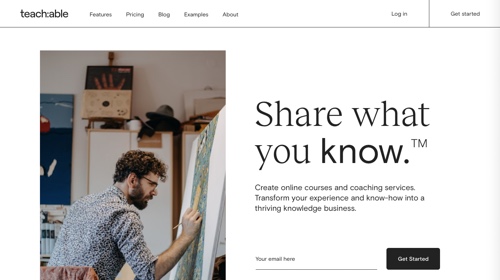
This is your store and an essential component of your organic traffic. As such, it should include a detailed catalog of all of your products and should be laid out in order to provide a simple, easy to use experience for your customers.
Along with a solid website, you’re going to want to set up a strategic social media presence. The word “strategic” is key here. Don’t set up an account on every platform or you’ll have trouble maintaining them all.
Set Yourself Up For Success
If you’re looking for ways to help strengthen your online presence, here are a few creative tips and ideas to get you started.
Even when your business takes place in the physical world — as is the case with those who sell handcrafted items — the internet can still be a major lifeline that connects you with your audience. This can happen through a quality website, tactful social media, and affiliate marketing.
- A good, working computer: You can also use a smartphone for communications such as faxes. The important thing is to make sure that you are very comfortable working on the devices that you have. You don’t want them holding you up as you work.
- A workflow system to keep track of everything: Whether you use a simple calendar, a homemade spreadsheet, or a fancier workflow app like Trello, find a system that you trust in order to keep track of everything that you have to do.
Consider Your Marketing Options
You can set up an affiliate program through sites like Affiliatly and then direct potential affiliates to sign up under your business’s account. From there, they can generate their own unique links and use them to promote your business.
- Organic search: This consists of traffic that is naturally channeled to your site from search engines.
- Direct traffic: This is when customers come directly to your site by clicking on a link on another site, in an email, or even typing your URL directly into the browser.
- Referral traffic: Referral traffic is directed to your site from others who are promoting your store or products.
- Social traffic: This consists of traffic that comes via social media content.
- Google My Business: Your Google My Business traffic comes from those who click on your business listing when it shows up next to Google search results.
- Paid traffic: Pay-per-click ads proactively send traffic to your site and charge you for each visitor that clicks on your ads.
- Omnichannel versus multichannel: Do you use all the marketing channels available to you or focus on just a few in order to maximize your strategic efforts?
Consider Your Marketing Venues
Time management and efficiency are both critical factors to establishing a larger online presence. This is where you’ll want to implement your workflow and scheduling tools in order to make sure that you have a way to execute each part of your marketing strategy without getting overwhelmed.
Your Website
Chances are you already focused on taking care of business licenses, accounting, taxes, and other minutiae, but you’re going to want to have a few tools in place when you go to create a marketing strategy, as well. There are two things, in particular, that you’re going to want to make sure you have ready to go:
You know how the old saying goes: a rising tide lifts all boats. The same concept goes for your online presence. The more you utilize tools like social media and techniques like search engine optimization, the better off your entire online brand will be. This is true even if you’re an entrepreneur who sells physical goods on a website or Etsy store. You’re still going to want to have a solid strategy for your online marketing.
However you choose to build your own marketing strategy, it’s important that you consider your time, set achievable goals, and only take on marketing plans that you can fit into your schedule. If you can do this efficiently, you’ll be able to build your online presence and, by extension, your business as well.
Finally, with all of these considerations, it’s important to take into account the time it will take you to execute each item. Creating content for your website, posting on social media, and running an affiliate program all take substantial amounts of time.
Social Media
Now that you have an idea of the tactics, let’s consider the primary online spaces you have to deploy them in.
The way you market yourself online will have a huge impact on your online presence. However, there isn’t a “one size fits all” solution for how to market a small business in the vast landscape of the internet. In order to bring some sense to the overwhelming number of options, it can be helpful to start with a broad categorization of the marketing tactics available. These include:
Affiliates
It should also include a company blog filled with content that establishes your authority on your craft and has naturally incorporated keywords and hyperlinks aimed at increasing your site’s SEO.
When it comes to marketing your handmade items, it’s tempting to think you should focus on social media areas like Pinterest and Facebook (and they’re definitely important!) however, you want to start with a solid, functioning website.
Manage Your Time
Focus on sites like Pinterest, Facebook, and Instagram, all of which are image-heavy and can serve as excellent channels to display your products.
Success often begins with your business tools. If you can’t run your operation efficiently, you’re going to have a hard time overcoming all of the other natural obstacles that come with starting your own business.
Building Your Online Presence
This could be an independent site on a website builder like WordPress or Shopify or it can be a store hosted on a site like Etsy or ArtFire. Whatever the case, you should treat your website as one of your key pieces of marketing collateral.
Affiliates are another excellent way to build your online presence. An affiliate promotes your products in exchange for a percentage of each sale. The nice thing about this is that you don’t have to pay anyone for promoting you until they make a sale.






![[VIDEO] The Quick (and Easy) Start to Omnichannel Optimization for Your Business](https://research-institute.org/wp-content/uploads/2021/07/video-the-quick-and-easy-start-to-omnichannel-optimization-for-your-business-768x576.jpg)
